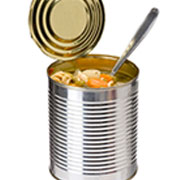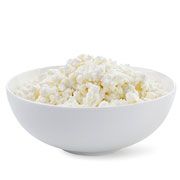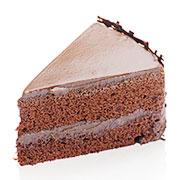
A Field Guide to Buying Low Sodium Foods
 The average person in the U.S. consumes 3,500 milligrams of sodium a day. That's equivalent to almost 9 grams of salt, or nearly 2 teaspoons - way more than the 2,300 milligrams per day suggested by the Dietary Guidelines for Americans.
The average person in the U.S. consumes 3,500 milligrams of sodium a day. That's equivalent to almost 9 grams of salt, or nearly 2 teaspoons - way more than the 2,300 milligrams per day suggested by the Dietary Guidelines for Americans.
The majority of excess salt, or 77%, isn't spooned into your food - it comes from processed foods.

*Percentages are calculated from the Institute of Medicine report that recommends 1,500 miligrams of salt each day as adequate for people ages 9-50; an older government standard of a 2,400 milligram daily intake appears on product labels, with correspondingly lower percentages.
General Guidelines
Read the ingredients on food labels and remove foods that are high in sodium. A good ballpark figure to strive for is to choose foods that contain less than 250 mg per serving. If your food contains more than this, eat less of it and have it less often.
Try as much as possible to eliminate FAST FOOD from your diet. If you're whipping through the drive thru, then, chances are good that the lions share of the sodium in your life is coming from here. The more you cook your own food in your own home, the better it will be for your heart: this will quite naturally lead to reduced sodium consumption, and increased potassium/magnesium.
When you do eat at home, check your canned food products for salt and sugar. You don't need their help salting and sugaring your foods. Get the ones without additive stuff, and just spice it up yourself.
Food Label Claims
Just know this, don't be upset by it, or weirded out by it, or wounded that humanity has "come to this," but, people who sell products will slant their pitch in any way they think they need to so you'll reach out your arm, grab their bag-o-whatever, and stick it in your basket. That's just the way things are. Welcome To Earth.
What's in a Name?
Some food label claims can't be trusted, and others can. When you read that this product or that product is sodium free, or low sodium, or reduced sodium ... what does that mean?
For this to make sense, let's define terms:
- Sodium-free: Less than 5 milligrams of sodium per serving
- Very low-sodium: 35 milligrams or less per serving
- Low-sodium: Less than 140 milligrams per serving
- Reduced sodium: Sodium level reduced by 25%
- Unsalted, no salt added, or without added salt: Made without the salt that's normally used, but still contains the sodium that's a natural part of the food itself.
When you're scanning a food label, don't just look for the word "salt." Watch out for various forms of sodium or other names for the same thing:

- sodium alginate
- sodium ascorbate
- sodium bicarbonate (baking soda)
- sodium benzoate
- sodium caseinate
- sodium chloride
- sodium citrate
- sodium hydroxide
- sodium saccharin
- sodium stearoyl lactylate
- sodium sulfite
- disodium phosphate
- monosodium glutamate (MSG)
- trisodium phosphate
- Na
When You Eat Out
The good part about eating out is that you don't have to fuss with preparing the food. The bad part is that you have zero idea what is in the food you're eating. Don't get discouraged, there are a couple of things to do to make healthier choices.
Keep in mind though, that you probably can't verify exactly what's in your lunch or dinner. That means that you'll have to use your best guess when you eat out. If you're having curly fries, chicken nuggets, and deep fried mayonnaise balls, you can be pretty confident that this is going to be awful for you.
Conversely, if you order salmon, or veggies, or some other obviously decent food, it's just not going to be as bad as whatever's greasing up the bottom of your fast food bag. Are those "better" choices pristine? You can't know that. In other words, you have to be at peace with the idea that you're close enough to fine.
Another good strategy is to choose a restaurant where food is made to order, and keep your order simple. Don't get foods that are pulled from under some food lamp. If it's made to order, the chances are better that the ingredients will be normal, and not something synthetic from Mars.
When possible, ask that your meal be prepared without any forms of sodium or MSG and then add a squeeze of lemon or lime on the end.
Sodium Sabotage
These are all food products that sound so healthy for you but are not at all. Look beyond the marketing, onto the back label, and you'll see why these foods should be bypassed altogether.
Bran Cereal with Raisins

Sounds good doesn't it? Raisins are good. Bran is good. In addition to the raisins and the bran, they managed to add 350 mg of sodium in a single cup. By contrast whole grain cereals have far less.
Pasta Sauce with Caramelized Onions and Roasted Garlic

The fresh ingredients shown on the front label make you feel like you're in Italy with some-a-body's a-mamma marinara. Remember to check the label, some pasta sauces can have as much as 510 mg of salt in just 1/2 cup.
Frozen Chipotle Black Bean Burger Patties

Trivia quiz: how do you take something as wonderfully healthy as black beans, and make them dramatically less healthy for you? Add 700 mg of sodium in a single burger. This is an item you would choose because you want to eat healthy, you know, for your heart!
Pumpernickel Bread

Pumpernickel bread is great for you! The vitamin B's are terrific for your heart. But wait. What happens when you add 190 mg of sodium for just one slice? It's suddenly not so good any more. Even if you had just one bread-on-bread sandwich, you'd have eaten 15% percent of your total sodium RDA. So, if you're going to have this bread, be sure to skip the meat and cheese.
Spicy Vegetable Juice

Another totally stealth item that is couched as healthy because of its vitamin C, but packed with sodium. There are low sodium versions that still have the healthy aspects of the vegetables, without throwing Salt Lake City in the process.
Canned Mushrooms

My mom used to cook with these little rubber pucks before we figured out that there was a non-dishwater version that had flavor, was better for you, and also didn't have 440 mg of sodium in just 1/2 cup. Mushrooms are great for you and taste amazing. Canned? Not so much.
Cooked Carved Chicken Breast, Southwestern Style Cooked Chicken Strips

A normal chicken breast has 45 mg of sodium. This has 10 times that. Is it because you never want it to go bad? So it will outlast a nuclear winter? So it can be the go-to food for long term deep space travel? Not sure but, until we figure this out, just make your own.
Whole Grain Plain Bagel

This is whole grain, which is why health-conscious people who need a bagel fix in the mornings, but can't pick it up from a bakery where they make them fresh, choose them. Some whole grain bagels can have as much sodium as a Slim Jim. A Slim Jim!! 490 mg in a single bagel.
Boxed Spanish Rice

Rice is, in fact, low in sodium because it's just rice. Check the label, some boxed rice products can have up to 1,250 mg of sodium in one cup of cooked rice. That's half of all you need in an entire day! Where is our sodium consumption coming from? It's not the salt shaker.
Frozen Mediterranean Style Shrimp and Penne Primavera

Just because the word 'Mediterranean' is printed on the box, along with a picture of a glass of white wine overlooking the caldera of Santorini, and a promise of the health benefits from this wonderful lifestyle ... doesn't make it healthy. What isn't printed on the box is a picture of your hardening arteries after consuming 890 mg of sodium per serving of this meal.
Homestyle Chicken Noodle Soup

Just like mamma used to make? Well, maybe if mamma used to use a salt shaker with a lid that perpetually came off, dumping 940 mg of sodium in just 1/2 cup of your soup. If mamma normally gave you 80% of all the sodium your arteries could handle in a day, with just one serving of one part of one meal.
1% Low-Fat Cottage Cheese

Talk about insult to injury. First of all, this stuff has the texture of cottage cheese. Next, it's 1% low-taste food. But then they put in 360 mg of sodium in 1/2 cup to make bland, bad for you. If you're going to suffer through flavorless cottage cheese, it should at the very least be good for you.
Packaged Harvest Bran Muffin

Some prepackaged bran muffins can contain 20% of all the sodium you need in a day (420 mg). The fiber here is great, and bran is definitely good for you, but harvesting this much salt into it should make you look for other sources of bran.
Frozen Baja-Style Chicken Quesadilla

Mmmm, I want to eat it and I haven't even seen the beautiful airbrushed picture plus health promises on the front. That said, I really don't know what Baja-Style means. Looking at the sodium content, I suppose that means 690 mg in a single package. Even though my mouth wants, whatever that is, I don't think my cardiovascular system is such a big fan.
Frozen Asian Vegetables in Sesame Ginger Sauce

Asian cultures have perhaps the heart-healthiest people on Planet Earth. So we should be able to be that healthy if we do what they're doing, with their vegetables [check], with sesame [check], and a ginger sauce [and check]. But what they don't point out in the healthy-sounding title is the high levels of sodium (630 mg in 1 cup!).
Foods you pretty much KNOW are not good
Beef Jerky Sticks

Surprised to find this impulse purchase staple of the gas station quickie mart? You may wonder whether this is beef jerky or "beef" Jerky, but you can be certain that the whatever it is that you're masticating will never degrade due to the levels of sodium it contains (500 mg in a single ounce).
Ketchup

Tomatoes are good. But the sugar and salt put into ketchup is just not. For every tablespoon you squirt on your already salty fries, you're getting an additional 190 mg of sodium. You know, people say that fried foods are bad for your heart, and they definitely can be. But when they become a vehicle for added salt, plus salty ketchup, then it just amplifies the problem. If you want a better condiment, malt vinegar is awesome, as is a spicy mustard.
Frozen Single-Serving Pepperoni Thin Crispy Crust Pizza

If you're still a young person, pulling a dorm room all-nighter, you're probably going to have something cheap like this - wait for it ... 1170 mg of sodium pizza. But because you're brain still hasn't fully grown in yet, you probably just don't really care. Once you reach full cranial capacity, you'll recognize that the pop-it-in-the-oven convenience and dirt cheap price is just not worth the sodium assault on your slowly hardening arteries.
Devil's Food Cake Mix

You probably think of this product as being too garishly oversweetened to be good for you, and it is. What's surprising is the added salt to complement the added sugar in this product. Just 1 piece of this cake (estimated to be 1/12 of the total) comes to 380 mg. You may not taste the salt because even that amount is swamped by the sugar flood, but your heart certainly realizes it's there.
Ramen Noodle Soup, Roast Chicken Flavor

All the deceptive advertising out there (and there's a ton) strives to make the purchase of unhealthily over-salted food seem like a good idea. In only half a package, your arteries are hit with 790 mg of sodium. Just taste it, and you'll see. Or better yet, don't.
Ham and Swiss Cheese with Crackers Packaged Lunch

Your easy lunch can contain up to 1130 mg(!!) of sodium in a single serving. Somehow that little factoid got relegated to the microfiche on the nutrition labeling in the back. A really good "lunchable" item that takes zero preparation is fruit and it doesn't give your children 60% of their recommended sodium for kids aged 4-8.
Even Plain Chicken?
You wouldn't expect normal uncooked chicken to be a significant source of sodium. Unfortunately, in our wide weird world of food, apparently it can - not because of the chicken, but because of the food processing that happens to it before it ever makes it to your grocery store.
Basically, the mass processed raw chickens are injected with saltwater solutions. A widespread practice in the poultry industry, manufacturers say it makes for tastier, juicier meat. Of course they do. This "saltwater plumping" also happens to make the bird heavier ... they're selling them by the pound ... so the more salt water they can squirt in there, the more profit they make.
Just check out the difference this makes for you. A serving of raw chicken breast contains between 50 to 75 mg of sodium. By contrast, the "enhanced" salt water injected chickens can contain well over 400 mg of sodium per serving.
Be sure to read the labels on the back to see if your manufacturer is plumping up your arteries with heart harming salt so they can sell their chickens for more than they're worth. It's not always easy to tell, either, because producers can label their chickens as "all natural", because it's just salt water. They can also advertise right on the bird with phrases such as "enhanced with chicken broth."